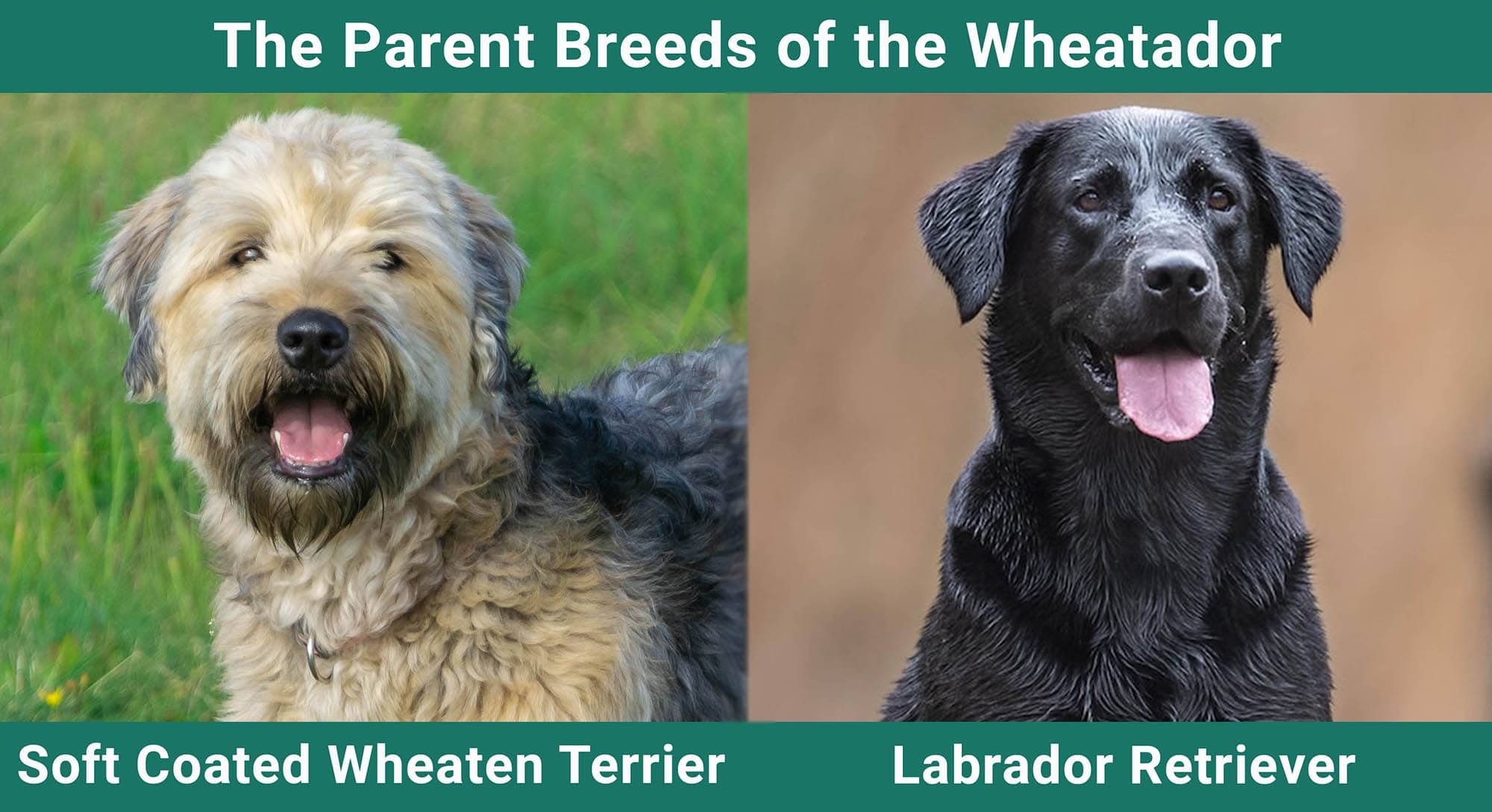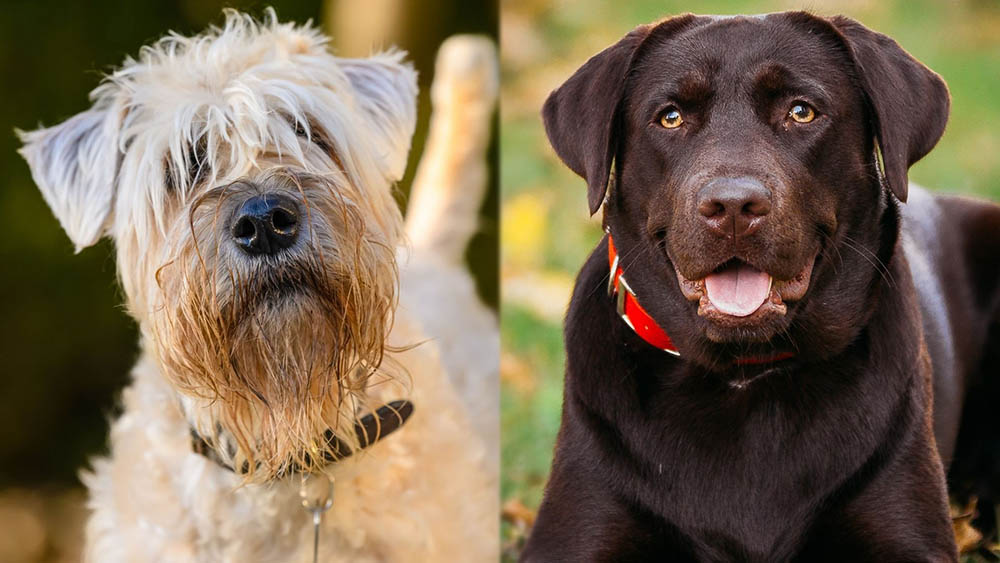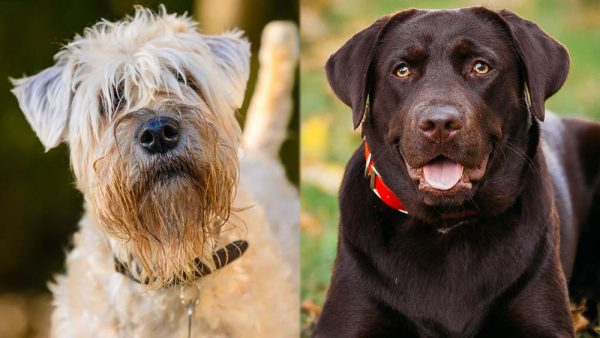Click Below to Skip Ahead
When you cross the ever-so-energetic and lovable Labrador Retriever with the devoted yet stubborn Soft-Coated Wheaten Terrier, you’ll end up with the best of both in the Wheatador.
The Wheatador is a mixed breed from two purebred parents, and if you’d like to learn more about this breed, keep reading!
Breed Overview
Height:
18 – 20 inches
Weight:
40 – 50 pounds
Lifespan:
11 – 14 years
Colors:
Cream, brown, black
Suitable for:
Active families or singles, house with a yard
Temperament:
Energetic, loving, devoted, friendly, affectionate, happy, stubborn
When dealing with a mixed breed like the Wheatador, you should always consider the parent breeds when you wish to know what their adult appearance and temperament might be like.
The Wheaten has soft, wavy hair, and the Lab has a short double coat. Both breeds are energetic and loving, but the Wheaten is a terrier, so you could end up with a stubborn or an easygoing dog, depending on which parent they take after the most.
The Wheaten is usually a soft cream color, and Labs can be cream, brown, or black, so you can expect the Wheatador to be one of these or a combination, which also includes the type of coat that they inherit.
Wheatador Characteristics

Wheatador Puppies
The Wheatador is not a common mixed breed, so you might have difficulty locating one. If you can’t find a Wheatador breeder, try talking to Lab or Wheaten breeders, as they might know where you can find one of these mixed dogs. If you do manage to find a breeder, you should ensure that they are reputable. Ask them questions, and request to see the puppies and their parents at the breeder’s home or kennels.
Also, try posting your interest in adopting a Wheatador online through social media. It might not take long for one of these pups to find their way to you!
There’s also adoption through a rescue group or animal shelter to consider, which is one of the best ways to get a dog. But when you’re looking for a specific breed, particularly a mixed breed, it might take a while, particularly if you have your heart set on a puppy.

Temperament & Intelligence of the Wheatador
Wheatadors are energetic and fun dogs that love playtime with their families. They are smart, but since they can be stubborn, you might find them trying at times. These friendly and social dogs tend to enjoy meeting people, which makes them not so great at being watch or guard dogs.
If they have more of their Wheaten parent in them, they will more likely be stubborn and strong-willed, while the Lab side will make them big, lovable goofballs.
Are These Dogs Good for Families?
The Wheatador makes an excellent family dog, but their terrier side can make them mouthy, so they should be supervised around young children. But that’s true for all dogs, no matter the temperament or size.
You should also teach your children how to treat dogs with love and respect. Riding a dog around like a horse or pulling on tails and ears should not be allowed. With proper guidance, the Wheatador will enjoy playing with the kids as much as they do cuddling up with them.
Does This Breed Get Along With Other Pets?
Labs get along well with other pets, but the Wheaten has terrier instincts that get in the way.
The Wheatador should be okay if they are raised and socialized alongside other animals, but they have a strong prey drive, particularly for small animals, which is something that you should be careful with when making introductions. Of course, it all depends on which parent the Wheatador takes after the most.

Things to Know When Owning a Wheatador
Food & Diet Requirements
It’s important to feed high-quality dog food to your Wheatador. You should aim for something designed for your dog’s current weight, age, and activity level. How much you feed your Wheatador will depend on your dog. You can follow the guidelines on your dog’s food bag and talk to your vet about the appropriate amount to feed them.
Beyond this, you should ensure that they have unlimited access to fresh and clean water and go easy on giving your dog too many treats.
Exercise
Since the Lab and the Wheaten are both high-energy dogs, the Wheatador will need quite a bit of exercise. A minimum of 60 minutes of exercise is necessary every day, which should include walks and playtime but can also include hiking, swimming, and any number of outdoor activities.
These are large and energetic dogs, and they will need a home with a yard and plenty of time spent with their family.
Training
The Labrador is known to be quite easy to train, but the Wheaten terrier is more of a challenge. The more terrier there is in your Wheatador, the more of a challenge their training will be.
That said, they are smart and devoted, so training them shouldn’t be too difficult. Plenty of patience and positive reinforcement are essential. If your dog is particularly stubborn, it may be best to take them to obedience classes.
Grooming ✂️
It all comes down to what kind of coat your Wheatador ends up with. Labs have short, water-repellent double coats, and Wheatens have long, soft, and silky single coats. Both breeds shed but the Lab definitely sheds more.
Wheatadors will inherit a bit of both coat types, but they likely won’t need brushing as frequently as their Wheaten parent. They might need weekly brushing, and if they inherit the Lab’s double coat, they’ll need daily brushing during the spring and fall shedding seasons.
Bathing your Wheatador with a good dog shampoo might only be necessary once a month or more. You’ll need to brush your Wheatador’s teeth daily or two to three times a week at the very least. You should trim your dog’s nails every 3 to 4 weeks and clean their ears about once a week.
Health and Conditions
A definite advantage of owning a mixed dog is they aren’t as prone to developing the same inherited genetic conditions as their purebred parents. But knowing the potential health conditions that their Lab and Wheaten parents might experience is still important so you know what to look out for.
- Skin allergies
- Flea allergies
- Cataracts
- Retinal dysplasia
- Hip dysplasia
- Protein-losing enteropathy
- Protein-losing nephropathy
Male vs. Female
In most cases, male dogs are larger than females, but when dealing with mixed breeds, there’s no fixed rule regarding size differences. Labradors are larger than Wheatens, so if a female dog takes after the Lab and a male takes after the Wheaten, she’ll likely be larger.
Other than size, there’s spaying and neutering to consider. Spaying a female dog is a more invasive surgery than neutering a male, which means more expense and recovery time.
Finally, it’s commonly observed that female dogs can be calm and easy to train yet moody, and male dogs are more affectionate and playful but prone to aggression. However, the best determinant of a dog’s personality is how they are raised and trained.

3 Little-Known Facts About the Wheatador
1. The Wheatador is prone to being allergic to fleas
The Soft-Coated Wheaten Terrier is quite likely to develop an allergy to fleas, so the Wheatador may have the same issue. This means you should be diligent in flea prevention with this breed.
2. The Wheatador is Canadian and Irish
The Soft-Coated Wheaten Terrier is an Irish breed that originated in the 1700s as a multipurpose farm dog for herding, ratting, guarding, and hunting.
The Labrador Retriever was one of two breeds discovered in the province of Newfoundland in Canada (the other being the Newfoundland Dog), which was used as a water retriever.
3. The Wheatador will be destructive without the right amount of exercise
Most dogs can become destructive in some way when they don’t receive the right amount of exercise.
The Wheatador comes from two high-energy parents, and with terrier instincts, they are known to be destructive and mischievous when they don’t receive at least 1 hour of exercise every day.
Final Thoughts
The Wheatador is the result of crossbreeding the Labrador Retriever and Soft-Coated Wheaten Terrier. Since both breeds are extraordinary dogs, you know that you’ll have an exceptional dog in the Wheatador.
They need an active owner who can keep up with their exercise needs and who knows how to train a stubborn dog. That said, Wheatadors are affectionate, playful, and devoted and will make the perfect companion for the right family.
See also:
- Can Dogs Eat Bread? Vet-Reviewed Types & Risks
- Neem Oil For Dogs: What Is It, Safety & Risks (Vet-Approved)
Featured Image Credit: (L) Wirestock Creators, Shutterstock | (R) Ajtai Krisztina, Shutterstock











